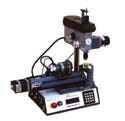May 19, 2005
Originally Published MPMN May 2005
PRODUCT UPDATE
Pulling It All Together: A Look at Extrusion and Tube Processing
Extruders and tubing materials suppliers keep up with new trends
Corinne Litchfield
|
The Smart Driller LT from Technical Innovations is designed to perform computer-controlled, repetitive hole drilling and skiving patterns. |
As medical technology becomes more advanced, medical manufacturers that provide equipment and services must rise to the challenge. Current developments include manufacturing small, complex products. This growing trend is particularly evident in extrusion and tube processing.
“Tubing is becoming tinier in size and more elaborate in configuration,” says Rikki Bauer, vice president of Medical Extrusion Technologies (Murrieta, CA). With a shift toward more minimally invasive surgeries, smaller incisions are required, which in turn requires smaller tubing and other materials. Companies specializing in extrusion and tube processing are developing machinery and other devices in order to meet these new demands. As Bauer puts it, “Equipment, technology, and R&D in the field of extrusion are becoming more important than ever.”
Hole-Punching Systems Create Multiple Hole Patterns
Automated catheter hole-drilling and hole-punching systems can store and recall 10 or more hole patterns. The Smart Driller LT and the Smart Puncher LT from Technical Innovations (Brazoria, TX) perform computer-controlled, repetitive hole-making, or skiving operations on single or multilumen tubing. The turnkey system has a pneumatic balloon grasper, a catheter guide made to application specifications, and an adjustable outboard stop. Target applications include high-volume, multiple hole pattern devices.
Porous PTFE Tubing and Extrusion is Offered
Porous polytetrafluoroethylene (PTFE) is a soft, flexible, fully fluorinated polymer with exceptional chemical resistance and temperature stability. International Polymer Engineering (Tempe, AZ) offers a porous PTFE that is 100% virgin and produced in a Class 10,000 cleanroom. The company has developed a line of microbore ePTFE and PTFE tubing and rod. Tubing sizes range from a 0.0366-in. inner diam with a 0.002-in. wall thickness, to a 0.068-in. inner diam with a 0.010-in. wall thickness. Rod sizes range from 0.008- to 0.038-in. outer diam. Extrusion capabilities include single- and multilumen tubing, profiles, and sheet. The company uses the latest polymer technology and automated extrusion techniques to reduce costs and shorten lead times.
Tubing Set Coiling Machine Also Works as a Winder
|
S-Y-M Products offers the Mini-Winder for coiling and packaging of tubing. |
A tubing set coiling machine offered by S-Y-M Products Co. (Stamford, CT) can serve as a conventional winder. The Mini-Winder, used in the manufacturing and assembly of disposable medical tubing devices, coils and packages tubing sets three times faster than conventional methods, according to the company. The product’s contact surfaces are stainless steel or high-density plastic, making it suitable for use in a cleanroom environment. A length of tubing is placed on the winder’s mandrel, which rotates the exact number of turns necessary to make the coil. The speed, coil size, rotation amount, motor direction, and mandrel height are all adjustable. After a coil is completed, the mandrel retracts, enabling the operator to slide the finished product into a package without excess movement. The winder comes equipped with foot and hand controls.
Optical Gauge Analyzes and Measures Multilayer Tubing
A gauging instrument provides advanced multilayer tubing thickness measurement. The DI 330 OptiGauge thickness measurement system from Lumetrics Inc. (West Henrietta, NY) uses optical technology to measure absolute thickness to ± 0.004 mil accuracy. Because the thickness of every layer is measured simultaneously, many types of translucent multilayer tubing or coating can be analyzed in detail. With a measurement rate of 30 Hz, the system can easily conduct an on-line inspection of a fast-moving web. Off-line inspections can also be performed.
Extruder Series Features Nonreactive Components
|
The GMP twin-screw extruder series from Leistritz features stainless-steel, nonreactive components. |
A twin-screw extruder series features precisely machined hardware and controls that meet FDA validation requirements. The Leistritz (Somerville, NJ) GMP series is suitable for tube extrusion, compounding, devolatilization, reactive processing, and foaming. Stainless-steel screws, barrels, and other parts that contact the processed materials are nonreactive, nonadditive, and nonabsorptive with the product being extruded. Screws and barrels are available in modular or one-piece designs, depending on the intended usage and required cleaning standards.
Extruder Produces Small-Diameter Tubing
|
Small-dimension medical and catheter tubing can be produced using a crosshead-type extruder from Wayne Machine. |
Small, crosshead-type medical grade extruders from 1¼4- to 5¼8-in. sizes have been introduced. The extruders from Wayne Machine (Totowa, NJ) are appropriate for producing small-dimension medical and catheter tubing, as well as precision medical products such as medical fiber-optic cables and fine medical-grade insulated wire. Key features of the extruders are industry-standard, feed-end-design extruder screws, feeding of polymer, no dynamic seals that can leak or cause surging, double-reduction helical gearboxes as found on larger machines, heavy-duty thrust bearings, timing belt drive for speed range changes and long-life ceramic heaters. High-temperature models are available for processing FEP, PFA, ETFE, ECTFE, and engineering polymers. The extruders can be customized.
Copyright ©2005 Medical Product Manufacturing News
You May Also Like






